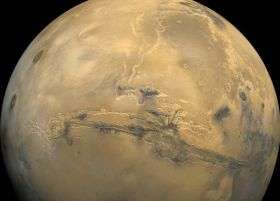Atmospheric origin of Martian interior layered deposits: Links to climate change and the global sulfur cycle

(PhysOrg.com) -- Researchers from the Planetary Science Institute (PSI) and NASA Johnson Space Center (JSC) have proposed a new hypothesis to explain a class of enigmatic geologic features on Mars that have puzzled scientists for decades. The new results, published recently in the journal Geology, suggest that large sedimentary deposits in the Valles Marineris termed Interior Layered Deposits (ILDs) may have formed in a cold, dry ancient Martian climate as the remnants of massive dust-rich glaciers that may have once filled this canyon system.
“Icy weathering might be a major part of the geologic story on Mars,” said PSI Research Scientist Joseph Michalski, “The planet has been in a cold, frozen state for a long time. In the distant past, it was also cold, but volcanoes were much more active, periodically pumping huge amounts of sulfur into the atmosphere, which could have ultimately ended up trapped within ice alongside plentiful dust.”
An atmospheric origin of Martian Interior Layered Deposits (ILDs): Links to Climate Change and the global sulfur cycle was written by Michalski and co-author Paul Niles of NASA’s JSC and was published online in Geology on March 26.
Valles Marineris is a 3,000 kilometer-long tectonic trough system on Mars, which reaches depths of approximately eight kilometers (five miles) below the surrounding terrain. Inside the canyon are vast mounds of layered sediments of enigmatic origins. Since their discovery by the Mariner 9 spacecraft about 40 years ago, the ILD deposits found within the Valles Marineris have escaped explanation. Their setting within the trough and canyon system has prompted some previous researchers to suggest that the ILDs formed from volcanic processes because the faulting and rifting that formed the canyon could easily lead to thinning of the crust, high heat flow, and ascent of magma.
However, in the late 1990s, the Thermal Emission Spectrometer instrument showed that the deposits contain gray hematite, similar to deposits explored at Meridiani Planum by the Mars Exploration Rover Opportunity. And shortly after, a French team of researchers produced intriguing new results that further complicated the interpretations of ILDs on Mars. They showed that the deposits contain sulfate minerals – which are typically found in desert playa or shallow sea environments on Earth and are not dominant phases in volcanic terrain.
One big part of the problem is the size of the altered, layered sediments that rise several kilometers from the canyon floor in places. Proposed ideas have included the suggestion that the canyon once housed a vast system of deep lakes. But, the canyon is not topographically constrained on all sides, so it is difficult to imagine how a lake could have existed there without spilling into the low topography to the north.
A number of recent publications have suggested that the sulfate-bearing ILDs formed by groundwater upwelling, where subsurface water breaches the surface during occasional upwelling events. This process has been invoked to explain most of the sulfate-bearing deposits on Mars.
However, Michalski and Niles point out that this process cannot explain the origin of the ILDs because they occur in deposits spanning all elevations of the canyon, and seemingly have draping sedimentary relationships against the canyon walls. If groundwater formed the ILDs, it would require that essentially all of they canyon was at one time filled with sulfur rich sediments. And, that scenario is simply not possible because it would require more sulfur than would have ever been available on Mars.
As an alternative, Michalski and Niles suggest that the ILDs formed from massive, dusty ice deposits that once filled much of the canyon. Such a scenario is consistent with the size, topographic configuration of the deposits, and with their mineralogy, which suggests weathering in an acidic, water-limited environment.
“Icy weathering might be a major part of the geologic story on Mars and should be much more important than the Earth because Mars lacks liquid surface water to buffer chemical processes” Michalski said. “ As was pointed out by the great mineralogist Roger Burns more than 20 years ago, icy systems should become very acidic on Mars.” In an article in Nature Geoscience in 2009, Niles led a paper proposing that these ice-dominated systems could also explain the origin of the deposits at Meridiani Planum.
“We are of the opinion that Mars has been cold and dry for quite a long time, and that during that time, the various cycles of dust deposition, ice precipitation and sublimation, and sulfur outgassing can explain quite a bit of the surface geology. Even so, the hypotheses are not without certain complications and uncertainties. It is our hope that more scientists will be begin to test these ideas.”
More information: Joseph Michalski, Planetary Science Institute, 1700 E. Ft. Lowell, Suite 106, Tucson, Arizona 85719, USA; and Paul B. Niles. Geology. Posted online 26 March 2012; doi: 10.1130/G32971.1
Journal information: Geology
Provided by Geological Society of America




















